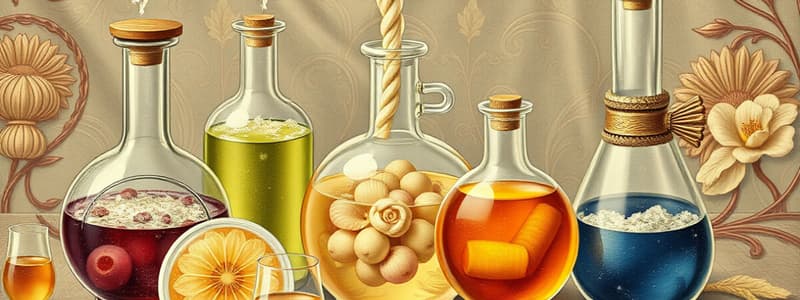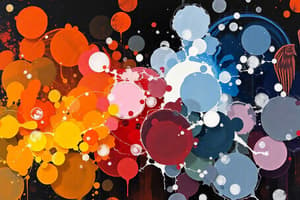Podcast
Questions and Answers
Which of the following best describes this substance: crystals of two different minerals, iron pyrite in quartz?
Which of the following best describes this substance: crystals of two different minerals, iron pyrite in quartz?
- Pure substance
- Element
- Homogeneous mixture
- Heterogeneous mixture (correct)
Is water a pure substance or a mixture?
Is water a pure substance or a mixture?
pure substance
Is water an element or a compound?
Is water an element or a compound?
compound
Is a sample where salt (NaCl) has been dissolved in water a pure substance or a mixture?
Is a sample where salt (NaCl) has been dissolved in water a pure substance or a mixture?
Is the salt-water mixture homogeneous or heterogeneous?
Is the salt-water mixture homogeneous or heterogeneous?
If hair clippings are added to water, is this mixture homogeneous or heterogeneous?
If hair clippings are added to water, is this mixture homogeneous or heterogeneous?
Classify the following: chunky peanut butter, apple juice, iron fillings.
Classify the following: chunky peanut butter, apple juice, iron fillings.
Classify each of the following pure substances as either an element or a compound: titanium, water, silver.
Classify each of the following pure substances as either an element or a compound: titanium, water, silver.
Classify each of the following pure substances as either an element or a compound: carbon tetrachloride, mercury, platinum.
Classify each of the following pure substances as either an element or a compound: carbon tetrachloride, mercury, platinum.
Classify each of the following pure substances as either an element or a compound: Cu, C12H22O11, NaOH.
Classify each of the following pure substances as either an element or a compound: Cu, C12H22O11, NaOH.
An element is a pure substance composed of only one kind of ___
An element is a pure substance composed of only one kind of ___
A compound is a pure substance composed of ___ or more elements.
A compound is a pure substance composed of ___ or more elements.
Which of the following are correct? (Select all that apply)
Which of the following are correct? (Select all that apply)
Complete the following operations by filling in the value of the exponent for the result: $5^3$ times $5^2$ = $5^{______}$
Complete the following operations by filling in the value of the exponent for the result: $5^3$ times $5^2$ = $5^{______}$
What is chemistry?
What is chemistry?
What is matter?
What is matter?
What is meant by macroscopic scale?
What is meant by macroscopic scale?
What is meant by atomic scale?
What is meant by atomic scale?
How many times taller are most people than a piece of paper?
How many times taller are most people than a piece of paper?
By how many orders of magnitude is the Empire State Building taller than a chair seat?
By how many orders of magnitude is the Empire State Building taller than a chair seat?
How many orders of magnitude larger is a person than a bacterial cell?
How many orders of magnitude larger is a person than a bacterial cell?
How many orders of magnitude larger is a bacterial cell than an aspirin molecule?
How many orders of magnitude larger is a bacterial cell than an aspirin molecule?
By how many orders of magnitude is a person larger than a molecule?
By how many orders of magnitude is a person larger than a molecule?
Classify the following as macroscopic-scale objects or atomic-scale objects:
Classify the following as macroscopic-scale objects or atomic-scale objects:
Classify the following as macroscopic, microscopic or atomic scale:
Classify the following as macroscopic, microscopic or atomic scale:
What are properties of matter?
What are properties of matter?
What is an element?
What is an element?
What is an atom?
What is an atom?
How many atoms is each sulfur atom bonded to?
How many atoms is each sulfur atom bonded to?
How many atoms make up a ring of sulfur?
How many atoms make up a ring of sulfur?
It would be possible to form rings with different numbers of atoms.
It would be possible to form rings with different numbers of atoms.
Does magnesium appear to have atoms bonded to just one or two other atoms?
Does magnesium appear to have atoms bonded to just one or two other atoms?
What other reactant is involved when methanol is ignited?
What other reactant is involved when methanol is ignited?
What are the products of the combustion of methanol?
What are the products of the combustion of methanol?
The process of converting CH3OH and O2 to CO2 and H2O is a chemical change.
The process of converting CH3OH and O2 to CO2 and H2O is a chemical change.
What is a chemical change?
What is a chemical change?
What is a mixture?
What is a mixture?
What is a homogeneous mixture?
What is a homogeneous mixture?
What is a heterogeneous mixture?
What is a heterogeneous mixture?
What best describes a chocolate chip cookie?
What best describes a chocolate chip cookie?
What best describes pure water?
What best describes pure water?
What best describes soda water?
What best describes soda water?
What best describes a diamond?
What best describes a diamond?
What best describes potassium dichromate K2Cr2O7?
What best describes potassium dichromate K2Cr2O7?
What best describes potassium dichromate K2Cr2O7 dissolved in water?
What best describes potassium dichromate K2Cr2O7 dissolved in water?
Study Notes
Exponential Properties
- ( x^{(a/b)} = (x^a)^{(1/b)} ) signifies exponent rules.
- When raising a variable to a power, multiply the exponents: ( (x^a)^b = x^{(ab)} ).
Chemistry Concepts
- Chemistry studies matter, its transformations, and behavior.
- Matter is any substance with mass that occupies space.
Scale Classifications
- Macroscopic Scale: Processes observable directly, such as water or baking powder.
- Atomic Scale: Measurement for individual atoms or molecules; not visible to the naked eye.
- Microscopic Scale: Objects too small for the naked eye but visible with an optical microscope, like bacterial cells.
Size Comparisons
- People are approximately 6 times taller than a piece of paper.
- The Empire State Building is 3 orders of magnitude taller than a chair seat (1,000 times).
- A person is about 6 orders of magnitude larger than a bacterial cell (1,000,000 times larger).
- A bacterial cell is 3 orders of magnitude larger than an aspirin molecule (1,000 times).
Substance Classifications
- Elements: Composed of one type of atom, e.g., Radon (Rn) and ozone (O3).
- Compounds: Combinations of two or more types of atoms, e.g., carbon dioxide (CO2).
Molecular Structure
- Nonmetallic elements like sulfur form rings of 8 atoms.
- Metallic elements, such as magnesium and tin, have atoms surrounded by many bonds.
States of Matter
- Solid: Definite shape and volume; atoms vibrate but do not move.
- Liquid: No definite shape but a definite volume; atoms/molecules can move past one another.
- Gas: No definite shape or volume; molecules show little interaction and fill their container.
Phase Changes
- Melting Point: Temperature at which solid converts to liquid.
- Freezing Point: Temperature for equilibrium between solid and liquid.
- Boiling Point: Temperature where vapor pressure equals external pressure.
Physical vs. Chemical Changes
- Physical Change: Involves properties without changing composition (e.g., evaporation).
- Chemical Change: Involves transformation into different substances (e.g., combustion of methanol produces CO2 and water).
Mixtures
- Mixture: Combination of substances retaining their identities.
- Homogeneous Mixture: Consistent properties throughout (e.g., pure water).
- Heterogeneous Mixture: Varying properties in different parts (e.g., chocolate chip cookie).
Substance Identification
- Water is a pure substance and compound (specific chemical composition).
- A saltwater solution is a mixture (combines water and salt).
- Heterogeneous mixtures can be separated physically (e.g., hair clippings in water).### Mixtures and Pure Substances
- Mixture Definition: Composed of two or more pure substances; can be separated by physical means.
- Homogeneous Mixture: Uniform appearance and composition throughout, often solutions.
- Heterogeneous Mixture: Non-uniform composition, visible distinct parts.
Examples of Mixtures
- Chunky peanut butter classified as a heterogeneous mixture due to visible separation.
- Apple juice classified as a homogeneous mixture; appears uniform and transparent.
Pure Substances
- Pure Substance Definition: Cannot be separated by physical means; consists of elements and compounds.
- Element Definition: Contains only one kind of atom, cannot be divided into simpler substances by ordinary chemical means.
- Compound Definition: Composed of two or more elements combined in a set ratio, can be separated into elements by chemical methods.
Examples of Pure Substances
- Titanium identified as an element (single type of atom).
- Water identified as a compound (H2O, made of hydrogen and oxygen).
- Silver identified as an element (single type of atom).
Additional Examples
- Carbon tetrachloride classified as a compound (CCl4, consists of carbon and chlorine).
- Mercury identified as an element (single type of atom).
- Platinum identified as an element (single type of atom).
Chemical Formula Representations
- Chemical Symbols: Elements use one- or two-letter symbols (e.g., Cu for copper, Hg for mercury).
- Compounds: Represented by a formula indicating elements present (e.g., C12H22O11 for sucrose, NaOH for sodium hydroxide).
Particulate Level Illustrations
- Element Representation: Comprised only of one type of atom; could be in any state of matter.
- Compound Representation: Composed of molecules containing two or more different types of atoms; also found in all states of matter.
Key Takeaways
- Identifying substances as pure or mixtures requires understanding their properties and composition.
- Recognizing elements and compounds is crucial in chemistry; each has distinct characteristics that determine their behavior and reactions.
Studying That Suits You
Use AI to generate personalized quizzes and flashcards to suit your learning preferences.
Description
Test your knowledge on the classification of substances with questions on minerals, water, and mixtures. This quiz covers definitions and characteristics of pure substances versus mixtures and asks to identify whether specific examples are homogeneous or heterogeneous. Dive into the world of chemistry and enhance your understanding!




